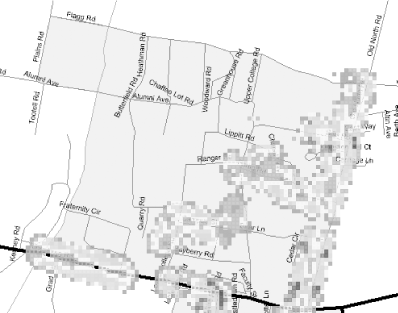10.5 Mapping Wi-Fi Networks with Kismet
| < Day Day Up > |
| We introduced Kismet in Chapter 3 as a powerful network scanner. You can also use it in conjunction with GPSd to map out the locations of Wi-Fi networks. (For the basics of getting Kismet running, see Chapter 3.) Once you have Kismet and GPSd up and running, you can make them work together.
To map networks with Kismet and GPSd:
When you shut down Kismet, it writes its log files. Check the logtemplate setting in kismet.conf to see where it puts its log files: logtemplate=/var/log/kismet/%n-%d-%i.%l Kismet writes several log files in the logtemplate directory ( I starts at 1 and increments for each time you run Kismet on a given day):
To generate a map, run gpsmap on the .gps log file. See the gpsmap manpage for all the drawing and mapping options. If you choose to use a downloaded map (the default), you must be online. Figure 10-8 shows a map generated by the following command: $ gpsmap -S3 -p /var/log/kismet/Kismet-Feb-16-2004-5.gps The -S option specifies which map server to use (0 = MapBlast;1 = MapPoint;2 = Terraserver; 3= Tiger Census). If you have trouble with one, try another (Tiger is loosely maintained by the Census Bureau and is not up 100 percent of the time). Use -p to show power levels or -e to plot simply the locations of the hotspots on the map (see the gpsmap manpage for more options). Figure 10-8. Wi-Fi power levels in the Kingston, Rhode Island area |
| < Day Day Up > |
EAN: 2147483647
Pages: 100
- Step 1.1 Install OpenSSH to Replace the Remote Access Protocols with Encrypted Versions
- Step 3.1 Use PuTTY as a Graphical Replacement for telnet and rlogin
- Step 4.5 How to use OpenSSH Passphrase Agents
- Step 4.6 How to use PuTTY Passphrase Agents
- Step 4.7 Using Public Key Authentication for Automated File Transfers
- Assessing Business-IT Alignment Maturity
- Linking the IT Balanced Scorecard to the Business Objectives at a Major Canadian Financial Group
- Technical Issues Related to IT Governance Tactics: Product Metrics, Measurements and Process Control
- Governing Information Technology Through COBIT
- Governance in IT Outsourcing Partnerships